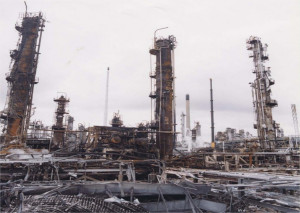A fire and explosion occurred on the saturate gas plant unit (SGP) of a refinery located on a 2-km2 site on the south bank of the Humber Estuary and treating about 225 000 US barils of crude oil a day. The site is divided by the A160 dual carriageway and bounded to the north by the railway line which separates the site from another refinery.
At 2.20 p.m., a catastrophic failure of a section of pipework on the SGP occurred at an elbow just downstream of a water-into-gas injection point (that was not part of the original design). The six inch diameter pipe, (the overhead line carrying flammable gas under high pressure) ruptured releasing a huge cloud containing around 90% ethane/propane/butane. The gas cloud ignited 30 s later, producing a massive explosion and fire. A further release caught fire around 2.35 p.m. resulting in a fireball. The fire, approximately 35-45m high and 30m wide, then extended to the Stabiliser and the Propane/Butane columns. As the fire burned, the overheating caused a number of failures of other pressurised pipework from loss of strength (domino effects). These contributed further quantities of fuel to the fire resulting in another fireball about 15 minutes later, subsequent smaller fireballs also followed. In total, 179 t of extremely flammable hydrocarbons were released , together with 0.5 t of hydrogen sulphide (SO2).
The internal emergency response team, backed by public fire-fighters and fire-fighters from the adjacent refinery brought the fire under control in 1 h and extinguished it by 8 p.m.
The SGP suffered very heavy damage as a result of both the blast and resultant fire and other on-site buildings were damaged up to 400 m from the explosion, causing the refinery to be shut down for several weeks. Extensive damage (broken windows, cracks in ceilings ) were reported to off-site homes and businesses within a 1-km radius. Debris from the explosion was spread over a wide area, up to 5 kilometres away.
The incident occurred on a Bank Holiday and during a shift changeover time: few people were out on site ; only 1 technician and 2 members of the public were slightly injured.
The examination of the pipework section recovered from the damage (internally coated with a passivation layer of black iron sulphide) showed that the elbow had failed owing to an erosion-corrosion’ damage mechanism which, over time, had reduced the wall thickness at the outside of the elbow from 8 mm to a 0.3 mm so that the wall could no longer withstand the internal pressure within. The pattern of thinning appeared to be directly associated with the water injection in the pipe which washed away the protective coating leaving it open to attack by corrosive agents in the gas stream.
The investigation carried out by the HSE revealed a systematic failure to understand the conditions that pipework was operating under, and to appropriately inspect pipework in the Saturate Gas Plant of the refinery. It also revealed failings in the operator management of change arrangements in that it had not correctly analysed the effects of an operating mode change (water injection point and subsequent procedures), and had not recorded it, leading to operators, inspection staff and monitoring staff not being as one to the actual operating arrangements on the plant. On 29th June 2005, the company were fined £800,000, plus £95,000 for other offences.
The company undertook a throughout piping inspection programme and the organisational structure was revised to provide clearer definitions of the responsibilities for mechanical integrity. The procedures for calling the emergency services, and for deciding when, and by whom, the off-site alarm should be sounded was improved. A third party audit of all the operator’s facilities worldwide was carried out.




